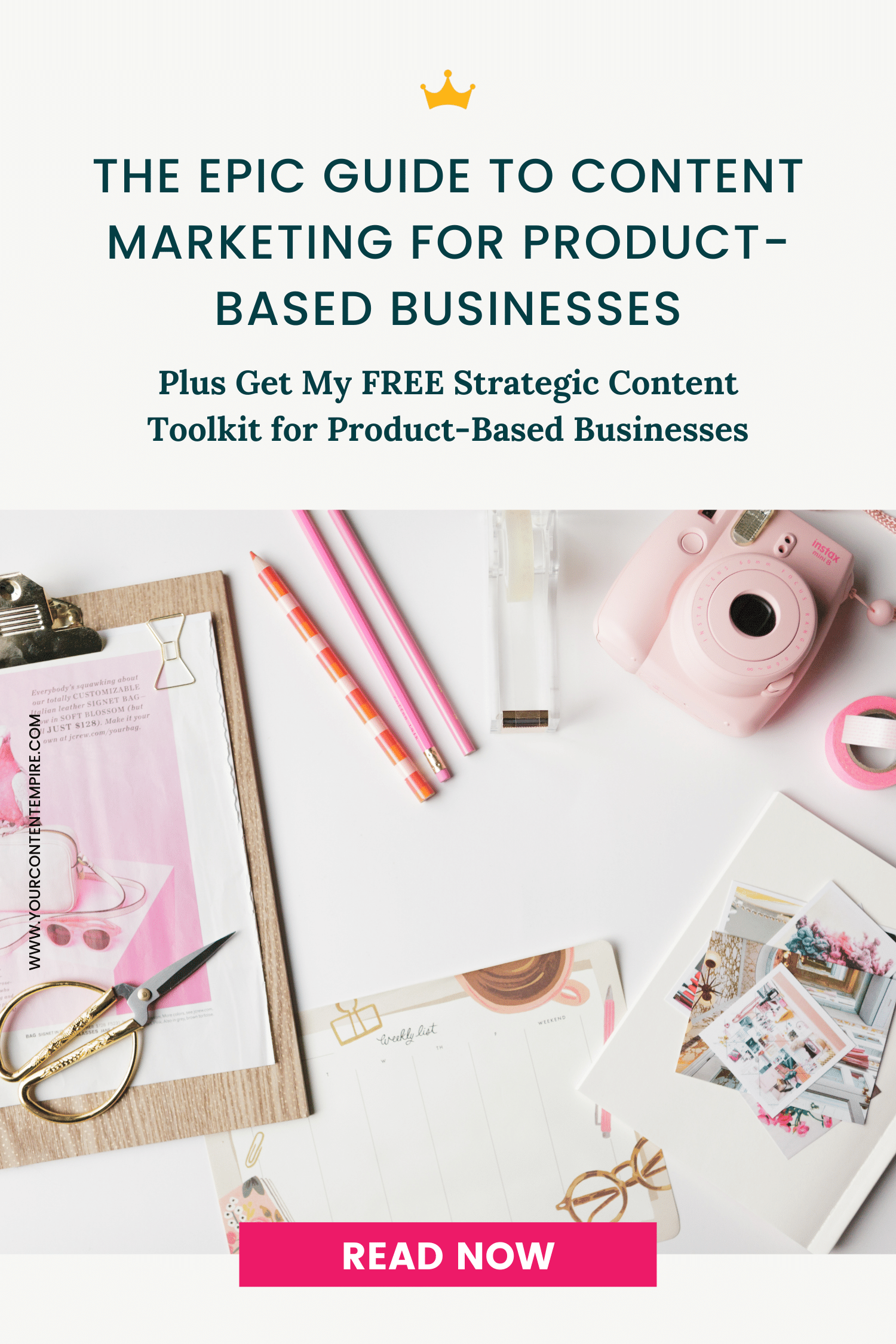
Sign up to get instant access to the Strategic Content Toolkit for Product-Based Businesses!
Want more profitable + strategic content? Grab my free content planner!


I’m Hailey – content strategist and founder here at Your Content Empire where we help you create more profitable, purposeful and productive content — and hopefully enjoy yourself more while doing it too. Learn more about me here >>

Want to know the ins-and-outs of content marketing for product businesses? There’s a lot to know if you want to craft an amazing blow-you-away content marketing plan for your product-based business.
I think it’s been fairly well-established that I’m a little bit (okay, a lotta bit) obsessed with content. I’ve written a ton about it, given interviews about it, created entire programs around it. But where I’ve lapsed is creating content that helps product-based business owners use content to reach their business goals.
Do I still think that content marketing is the way to go for a product-based business? Heck yes! But even though much of the same content strategies apply to both service & product business, there’s a lot that has to be tweaked and tailored to fit each one.
So I’ve pulled together my best tips for creating a content marketing strategy specifically for businesses that are product-based. Don’t forget to also download the Strategic Content Toolkit for Product-Based Businesses.
Content goals will vary from business to business and will be determined by what your overall business goals are but these are the 3 main categories of content goals for product businesses.
One aim of your content is to make purchasing your product as smooth and easy as possible. This can be achieved by making it easy to find your products including links within your content, utilizing retargeting advertising, and structuring your website with user-experience in mind.
Another way to achieve this is to use your content to address purchase objections. You don’t want to get caught with your head in the sand! Knowing all of the reasons why someone wouldn’t buy your product will help you create content that specifically addresses those concerns.
Takeaway Action: Create a list of why someone wouldn’t want to buy your products.
One place where a lot of product-based business owners get stuck is with their email list.
What can I send? How do I get people to sign up?
And because they don’t have an easy answer to these questions, they don’t really bother with an email list. But just like with a service business, an email list is your ticket to staying in touch with your potential clients and providing value over time.
If someone lands on your site and doesn’t sign up for your list or purchase something during their visit, chances are you won’t see them again. With an email list and strategy, you can take that relationship with your prospects into your own hands and nurture it.
As for answering those questions above, scroll on, product warrior, there’s a section on Your Newsletter Strategy coming!
The final content goal category is around building brand awareness so that when your ideal customers are in the market for your product, you’re the first business they think of. The main way this is achieved is by choosing platforms (social media, traditional media) where your ideal customers consume content.
So all of those so-called vanity goals of ten trillion followers on Instagram aren’t entirely vain after all. The aim is to increase your number of engaged followers though on whatever platforms you choose.
Here are my main, tried-and-true strategic tools for the product business to have in place before you even think about creating your content strategy.
Go ahead and roll your eyes if you’ve heard this one before. But there’s a reason it’s pretty much become a cliché.
If you water down your message because you’re trying to make it appeal to the most people, you’ll end up attracting no one.
Now if you take the opposite approach (which may seem a little bit counterintuitive right now), and hone in on 1 customer type, your ability to articulate exactly what they’re struggling with and want most from a solution will prove that your product is the one for them. Your message will gain the clarity and focus needed to make a significant impact.
The best part about having a content strategy is that it takes you from being reactive with your content and throwing out random posts on a whim to being intentional with content. This helps you to mindfully take your readers on a journey from completely-new-to-you to a reader to a first-time-customer to a brand advocate.
The best way to do this is to map out your customer’s journey and match each part of it with the content that’s best suited to move them along the customer journey continuum.
Takeaway Action: Create a customer journey map.
What makes your business different from companies selling similar products? Your unique selling proposition.
Having a clear idea about what makes you stand out from the crowd will help you articulate it throughout your content AND will help you overcome any competition (competition doesn’t exist if you focus on what makes you unique!)
This is actually a great exercise to do every 3 months or so because it helps you identify the opportunities and potential potholes that are on your current playfield field (the present reality of your business).
By doing this when I was just starting my business in 2014, I was able to identify a partnership that ended up providing more than half of my income for my first year of business. Even though I’m a service-based business, it still has mega-applications for product businesses (identifying influencers, new markets, new distribution channels, exciting content projects – seriously, I could go on forever).
Takeaway Action: Complete a SWOT table of what’s currently happening in your business. Once we have that information, you’ll be able to make some strategic decisions about your content! Download the workbook here if you’d like.
This strategic tool basically just refers to the ratio for you to keep central to any content that you produce – a rule of thumb that will help your content reach the targets you’re hoping for.
Because it isn’t simply enough to just publish and hope people will come and read it.
So here’s the ratio: For every piece of content you produce, spend at least as much time promoting it. Without promotion, your content’s a deserted island. If you want people to visit it, you’re going to have to provide some boats and ferries.
The next step in creating your product-based business content strategy is to develop your content brand. If you already have a strong brand and style guide for your business, this will be easy. If not, you'll probably want to go back and start there, carry it through to your website, packaging and other brand touchpoints before starting on this step.
Content is an outlet for your brand, an incredibly important one, but it still flows from your brand, not separately.
Here are the two main things to consider when developing your content brand:
Your content plays a big role in building brand recognition for your products. But in order to do this, you have to carry through your brand's stylistic elements throughout your branded content images on a consistent basis.
You want to have a blog style defined with the following types of guidelines specified: header formatting, text formatting, blog image templates, social media image templates, product display shot templates, etc.
Takeaway Action: Read this blog post about the cheat to creating branded image templates and get started creating your blog style guide.
The visuals are just one tiny piece of your brand. Another piece is your brand voice and personality. This is one of the biggest differences between a service and product business. A service business has to be much more of a personal brand because people are signing up to work with you and/or your contractors/employees.
With a product business – you get to develop your brand voice. There are some best practices that will help you narrow it down but the most important thing to remember is to be consistent. So once you have it defined, stick to it.
Answer these questions to start defining your brand voice:
Relationship
Speaking their language
Use these answers to guide your content creation and language throughout any of your business’ brand touchpoints (website, social media, blog, newsletter, packaging, product descriptions, sales materials, email templates, customer service, etc.)
Takeaway Action: Once you’ve answered these questions, create your brand bank full of terminology, customer-based descriptions, phrases and keywords.
As mentioned earlier in this post, for a product-based business, the purpose of your content falls into a least one of the previously-mentioned Content Goals:
What the heck am I supposed to write about on my blog? People don't just want to hear about my product all the time – so what else is there?
Here are some types of blog content that perfectly pair with a product-based business:
Kind of a no-brainer but around a quarter of your posts should showcase your product, feature different versions, announce updates or explore a feature (or benefit) in depth.
One way to make these posts more engaging? Include beautiful photos of your products or mockups.
Another good content type is to feature the users and how they’ve used the product (admittedly – this is easier with B2B businesses whose users wouldn’t mind the coverage).
You can also do an interview with users or customers with pre-set questions so it’s easy to just send to them to fill out and then publish.
If you don’t have any customers who would be willing to do this type of post, you can start by doing features, collaborations or interviews with people in similar industries.
For example – if you sell jewelry, partner with a t-shirt company and show off some great t-shirt-jewelry pairings plus interview the business owner. You could even arrange for a cross feature: you feature her and she features you.
Another easy post category is the how-to-use it style posts that you can use to inspire customers and show all of the ways they can use the product:
This will really depend on what your product is but the purpose of this style of post is to inspire your potential customer and help expand their current set of beliefs about how they could use this product by showing them a whole other range of possibilities.
The fourth major category of content for product-based business is lifestyle or general business based posts (depending on if your company sells its products to other businesses or to consumers).
To come up with lifestyle content categories, you’ll want to first niche out so you can then niche in.
Takeaway Action: Come up with your content categories and use this to brainstorm ideas. You’ll find the worksheet in the workbook.
As mentioned above, one of the main purposes of your content strategy as a product-based business is to build your email list.
But just using it for sales emails and only sending something when you have something to sell? Lame.
Even as a product-based business, your newsletter is still one of the best tools you have to build a relationship with your customers, keep your products and business top-of-mind and to get them used to seeing you show up in their inbox regularly with fun stuff to show them.
This section will give you some specifics on creating your newsletter strategy.
Here’s another point of confusion especially for product-based businesses. How can you send them an opt-in that relates to your product? Especially if it’s a physical product and sending free samples just isn’t feasible or fit with your business model.
Here are some options that might be perfect for your newsletter strategy:
So now that you have your newsletter set up and a sign-up gift in place to entice your potential customers to join your list in the first place, it’s time to come up with a plan of what you’ll send.
Step 1. Choose your frequency
You should be sending something to your email list at least once a month. Otherwise, your subscribers won’t remember why they signed up in the first place.
Step 2. Decide what you’ll send
Choose 1-2 types of emails you’ll send to your list (aside from promotional emails)
Here are some ideas:
Takeaway Action: Decide on your email newsletter plan – what free gift you’ll use and what you’ll be sending in your regular emails.
As a product-based business, here are your 3 biggest content marketing secret weapons:
Using retargeting to put Facebook or Google ads in front of people who have visited certain pages of your website is an affordable and strategic way to market to an audience who already has your products on their mind.
You can target people who are previous customers, people who have abandoned items in their shopping cart or if they’ve browsed particular products.
Either learn how to use this tool or hire a content strategist to help you set it up as part of your content strategy – it’s one of the most powerful tools at your disposal.
It’s much easier to get a product in the hands of an influential blogger or company than a service. Use this to your advantage, look for influential people who your potential customers follow and trust.
The right partnership could mean breaking into a whole new market full of potential customers who weren’t aware of your products before. This sort of outreach should have a central role in your content strategy.
Newton’s First Law of Motion states that an object at rest tends to stay at rest and an object in motion tends to stay in motion unless an external force is applied.
This is just like your existing customers (in motion) versus potential customers (at rest). It takes a lot more energy to get potential customers to move past the potential phase than it does to motivate your existing customers to become return customers (especially if you’re wowed at every step in their customer journey).
So in what ways can you channel the energy from your existing customers into returning or even new customers? Here are some ideas:
Content marketing, in general, is one thing, but content marketing specifically for product-based businesses is another. If you’re not carefully crafting your marketing plan for your type of business, you could be missing out on little tweaks you can make that will make your content strategy that much more powerful.
Sign up for the Strategic Content Toolkit for Product-Based Businesses to get started on creating your product-based content marketing strategy.
Tired of staring at a blank screen, wondering what to post? What if I told you I create 260+ pieces of content every year without breaking a sweat? Today, I'm giving away my entire daily writing system – the exact process I use to never run out of ideas and...
Are you stuck at full capacity but afraid to raise your prices? One of my clients just ran a price raising campaign that converted at 35% - with mostly existing leads? Today, I'm giving you my exact step-by-step campaign framework for raising your prices without...
Want to know the #1 reason your content isn't getting results? I see it all the time: business owners diving into content planning, color-coded editorial calendars, and posting schedules without the ONE thing (hint: it's a one page content strategy template) that...